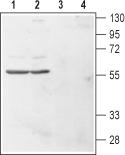HRH4 Rabbit Polyclonal Antibody
Other products for "HRH4"
Specifications
| Product Data | |
| Applications | FC, WB |
| Recommended Dilution | WB: 1:200-1:2000; IHC: 1:100-1:3,000; FC: 1:50-1:600 |
| Reactivities | Human |
| Host | Rabbit |
| Clonality | Polyclonal |
| Immunogen | Peptide HTLFEWDFGKEIC, corresponding to amino acids 75-87 of human H4 Histamine Receptor. 1st extracellular loop. |
| Formulation | Lyophilized. Concentration before lyophilization ~0.8mg/ml (lot dependent, please refer to CoA along with shipment for actual concentration). Buffer before lyophilization: Phosphate buffered saline (PBS), pH 7.4, 1% BSA, 0.025% NaN3. |
| Purification | Affinity purified on immobilized antigen. |
| Conjugation | Unconjugated |
| Storage | Store at -20°C as received. |
| Stability | Stable for 12 months from date of receipt. |
| Gene Name | histamine receptor H4 |
| Database Link | |
| Background | Histamine (2-[4-imidazole]ethylamine) is a low-molecular-weight amine synthesized from L-histidine. It is produced by various cells throughout the body, including central nervous system neurons, gastric mucosa parietal cells, mast cells, basophils and lymphocytes. Histamine is a major biological mediator whose functions include, among many others, regulation of vascular smooth muscle, immune regulation, regulation of sleep-wake cycles and regulation of gastric acid secretion. The biological effects of histamine are mediated through four receptors (H1- H4 Histamine receptors) all of which belong to the 7-transmembrane domain, G protein-coupled receptor (GPCR) superfamily. H4 Histamine Receptor couples to Gi/G0 proteins and receptor activation leads to inhibition of adenylate cyclase, mobilisation of calcium from intracellular stores and activation of the mitogen-activated protein kinase (MAPK) cascade. H4 Histamine Receptor is largely expressed in haemopoietic cells including mast cells, eosinophils, dendritic cells and T lymphocytes. H4 Histamine Receptors modulate eosinophil migration and the selective recruitment of mast cells leading to amplification of histamine-mediated immune responses. In addition, H4 Histamine Receptors are involved in dendritic cell activation and the regulation of T lymphocyte cytokine production. These studies indicate that H4 Histamine Receptor is an attractive therapeutic target for the treatment of inflammatory disorders, such as allergy, asthma, chronic pruritus and autoimmune diseases. |
| Synonyms | AXOR35; BG26; GPCR105; GPRv53; H4; H4R; HH4R |
| Reference Data | |
| Protein Families | Druggable Genome, GPCR, Transmembrane |
| Protein Pathways | Neuroactive ligand-receptor interaction |
Documents
| Product Manuals |
| FAQs |
{0} Product Review(s)
0 Product Review(s)
Submit review
Be the first one to submit a review
Product Citations
*Delivery time may vary from web posted schedule. Occasional delays may occur due to unforeseen
complexities in the preparation of your product. International customers may expect an additional 1-2 weeks
in shipping.






























































































































































































































































 Germany
Germany
 Japan
Japan
 United Kingdom
United Kingdom
 China
China




